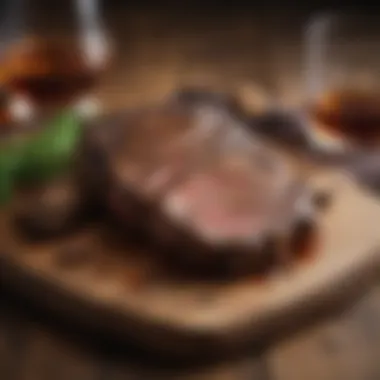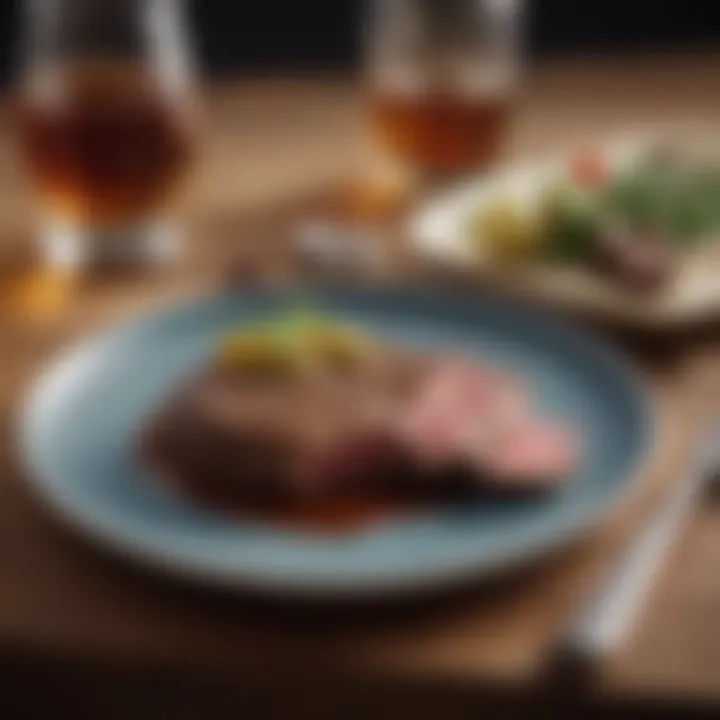Steak and Whiskey Pairing: A Culinary Journey


Intro
Pairing steak and whiskey is like finding that perfect dance partner—one enhances the other’s best features, creating a delightful experience for the senses. Both steak and whiskey have rich histories and a unique cultural significance that transcends mere consumption. From the smoky depth of a finely aged bourbon to the savory char of a perfectly grilled ribeye, understanding how these two culinary standards complement each other can elevate your dining experience from ordinary to extraordinary.
The essence of pairing these staples lies not just in the flavors themselves, but in the stories they tell, the regions they originate from, and the science that binds their flavors together. Whether you’re unwinding after a long day or engaging in a celebratory feast, knowing the ins and outs of this pairing can transform a meal into an artful occasion.
This article dives headfirst into the intricate relationship between steak and whiskey, covering aspects from origin stories to flavor profiles and everything in between. We'll explore not just how to find your favorite pairings, but also the preparation techniques that work wonders when it comes to enhancing taste and texture. Let’s embark on this culinary journey, designed for food lovers of all ages, and discover how to create pairings that are both memorable and satisfying.
Foreword to Steak and Whiskey
Steak and whiskey stand as two titans of the culinary world, each boasting a rich vocabulary of flavors and cultures. Their pairing is not merely about taste; it’s a harmonious dance of tradition, texture, and innovation. This section delves into the significance of both steak and whiskey, setting the stage for understanding how they can elevate each other when brought together on the plate.
Historical Context of Steak
The history of steak is a tapestry woven from the practices of our ancestors. Dating back thousands of years, the act of cooking meat over an open fire was not just about sustenance; it became a rite, a symbol of community and festivity. Early human beings hunted various animals, but it was the domestication of cattle that heralded the age of steak.
In fact, steak has roots in various cultures—from the gauchos of Argentina, who grill large cuts on open flames, to the classic French bistro, where a entrecôte can often steal the show. Noteworthy is the fact that the method of cooking has evolved too. Initially, the focus was on survival, but today it has morphed into an art form where grilling, broiling, or pan-searing each reveal unique characteristics of the meat. The beef we savor now has been influenced by generations of careful breeding and techniques that enhance tenderness and marbling. This historical backdrop enables us to appreciate steak not only as a meal but as cultural artifact that conveys a rich and complex narrative.
The Evolution of Whiskey Production
Turning to whiskey, its own historical journey is steeped in craftsmanship and tradition. The earliest references date back to the 15th century in Ireland and Scotland, where it was distilled primarily for medicinal purposes. Over time, regional distinctions began to surface, giving rise to varieties that reflect local grains, water sources, and methods. The production process has undergone significant refinement, evolving from rudimentary pot stills to sophisticated column stills, enhancing both efficiency and flavor extraction.
What marks the evolution of whiskey today is not just the process but also the growing appreciation of its complexities. Modern distillers experiment with diverse barrels for aging, such as those previously used for bourbon or sherry, infusing flavors that add layers to the spirit. This modernization combined with adherence to tradition creates a whiskey landscape rich with possibility—making it a worthy companion for steak.
In summary, understanding the historical contexts of both steak and whiskey allows food enthusiasts to appreciate not only what they are eating or drinking, but also the stories that come alive with each bite and sip. When they unite, the experience becomes a celebration of flavor and culture.
"Great food and drink are about expression—not just the ingredients, but the craftsmanship behind them."
Hence, recognizing these histories is crucial as we delve more deeply into pairing techniques in the following sections.
Flavor Profiles and Pairing Principles
In the world of culinary arts, understanding flavor profiles and pairing principles is crucial for any chef or home cook who aspires to create harmonious dishes. When one considers the bold tastes of steak and the complexity of whiskey, the stakes—pun intended—are higher than ever. A sound grasp of flavor profiles not only enhances the individual elements of a dish but also elevates the entire dining experience. Why is this important?
The very essence of savoring food and drink lies in the interplay of flavors. When executed properly, this harmony can transport your palate to unexpected heights. Think of the marriage between a smoky ribeye and a peaty Scotch; it's a match made in heaven, and knowledge of flavor profiles helps achieve such culinary magic. Paying attention to how elements interact—whether to complement or contrast flavors—can make or break a meal.
Understanding Taste and Aroma
Taste and aroma are two sides of the same coin, and together they create the unique experience of flavor. When one thinks about steak and whiskey, it’s useful to remotely dismantle what these flavors entail.
We have five basic tastes: sweet, sour, salty, bitter, and umami. The rich, savory notes of steak often bring forth umami, while whiskey can introduce sweetness, particularly in bourbons. Add a touch of smokiness from a well-charred steak and you will find certain whiskeys—a highland malt, for instance—play beautifully well with those characteristics. Aroma pulls the strings of memory, nostalgia, and even emotion, creating an enveloping dining experience.
Being conscious of these taste and aroma elements allows the cook to highlight favorable aspects and downplay less desirable ones, forging a path toward a thrilling culinary adventure.
Key Pairing Concepts
Pairing principles guide the marriage of food and whiskey in ways that enhance the overall experience. In this section, we explore three important concepts: complementary vs. contrasting flavors, the role of texture, and balancing intensity.
Complementary vs. Contrasting Flavors
One must ask: how do complementary and contrasting flavors shape our dining experience? Complementary flavors blend seamlessly, creating a smooth symphony on the palate. The idea is to enhance similar notes—like pairing a sweet bourbon with a steak seasoned with brown sugar. Contrasting flavors, on the other hand, introduce an element of surprise; think of a spicy Cajun steak alongside a sweet Irish whiskey. Not only do these choices bring variety but they also evoke a richer tasting experience.
Key Characteristic: Complementary pairings tend to create a harmonious encounter while contrasting flavors add excitement and interest.
Unique Feature:
These flavor types serve the purpose of guiding your palate from one taste to another, avoiding monotony in the dining experience.
Advantages/Disadvantages: While complementary flavors may lead to a universally accepted combination, contrasting flavors invite exploration and can please adventurous diners looking for something off the beaten path.
The Role of Texture
Texture often goes unnoticed in discussions about flavor, yet it forms a foundation for appreciating certain pairings. Picture a tender filet mignon with a velvety mouthfeel; now, add a smooth whiskey to match. Alternatively, a coarse-cut steak might demand a bolder, spicier whiskey to stand up to its texture. Texture provides a physical sensation that enhances flavors and shapes the overall dining experience.
Key Characteristic:
Texture can either soften or amplify flavors, making choices in pairing even more vital.
Unique Feature:
By understanding texture, you can smarten up your pairings and avoid a mundane mouthfeel.
Advantages/Disadvantages:
A well-structured pairing in terms of texture can create balance, while a poor choice may lead to overwhelming sensation that distracts from the taste of either the steak or whiskey.
Balancing Intensity
Intensity is all about how bold or delicate flavors can be. An intense whiskey demands an equally robust steak, or else the flavor of the whiskey may overshadow the subtle nuances of the meat. Conversely, a subtle whiskey suits a more delicately prepared steak. Achieving the right balance brings forth the best in both elements.
Key Characteristic:
Balancing intensity determines how flavors interact and whether one elevates or diminishes the other.
Unique Feature:
Fine-tuning intensity can transform an average meal into a standout occasion.
Advantages/Disadvantages:
Getting it right can create an unforgettable dining moment, while mismatched intensities can lead to one note completely dominating the experience, leaving the diner unsatisfied.
The art of pairing steak with whiskey doesn’t just lie in the choice of ingredients; it hinges on a deep understanding of these flavor principles. With the right knowledge, food lovers can turn a simple meal into a memorable feast.
Types of Steak Cuts and Their Characteristics
When it comes to steak and whiskey pairing, understanding the nuances of different cuts is paramount. Each cut of beef comes from distinct parts of the animal, which influences its flavor, tenderness, and fat content. These factors play a crucial role in how well they can be complemented by different whiskey varieties. By knowing the characteristics of various steak cuts, enthusiasts and chefs alike can make informed choices that enhance both the steak's flavor and the whiskey's profile.
Popular Cuts of Steak


Filet Mignon
The filet mignon stands out for its tenderness. It is cut from the smaller end of the tenderloin, resulting in a buttery texture that practically melts in your mouth. This cut is often considered a premium option, thanks to its mild beef flavor and incredible tenderness, making it a favored choice in fine dining.
In the context of pairing, filet mignon's subtlety means it works best with whiskeys that have a smooth and soft profile, like a well-rounded bourbon. A bourbon with light vanilla notes complements the flavor of the meat without overpowering it. Still, the cut lacks the intense flavor that some might desire, which could make it less satisfying for those who prefer a bolder taste.
Ribeye
Ribeye is another popular favorite, well-loved for its rich marbling and robust flavor. It comes from the rib section, and the fat content gives it a juiciness that is hard to beat. The flavor profile is rich and beefy, making it a satisfying choice for steak lovers.
When paired with whiskey, ribeye’s richness can stand up to more complex spirits, such as a high-proof rye. The spicy notes of rye complement the savory, umami characteristics of the steak, creating a harmonious balance. However, some might find ribeye’s higher fat content can muddle the whiskey's flavor if not chosen wisely.
T-Bone
The T-bone offers the best of both worlds, featuring a section of tenderloin on one side and a strip steak on the other. This combination showcases a range of textures and flavors all in one cut. The presence of the bone adds to the flavors during cooking, as it helps to retain moisture and enhance the overall taste of the dish.
For pairing, T-bone can be versatile; its complex profile pairs well with both bourbon and scotch. A smoky Islay scotch can play beautifully against the beefy richness, while a sweeter bourbon can highlight the tenderloin's softer notes. The varied tastes in this cut can also be a double-edged sword, as the inconsistencies in flavor between the two sides might not appeal to everyone.
The Influence of Cooking Methods
The method of cooking steak can drastically change its flavor and texture, which subsequently influences pairing options with whiskey. Knowing how these methods affect the meat allows for a more tailored approach to selecting the right whiskey.
Grilling
Grilling is perhaps the most renowned method of cooking steak, celebrated for imparting a distinct smoky flavor. The high heat that grilling employs caramelizes the surface of the steak, creating a crust that locks in juices while giving an enhanced aromatic profile.
This method complements whiskey options that contain oaky and charred tones, making it a fine pairing with bourbon. The sweetness achieved through caramelization of the meat can mirror the sweet vanilla notes often found in bourbon. However, it’s worth noting that grilling can lead to a loss of moisture, which may require careful attention during cooking to avoid dryness.
Pan-Seering
In contrast, pan-seering offers a different experience. By cooking the steak in a hot skillet, you achieve a beautiful crust with a juicy interior. The fond created in the pan can be utilized for sauces, enriching the dish further.
This cooking method shines when paired with whiskeys that have bold profiles, like a cask strength bourbon or a spicy rye. The caramel notes from the pan-seered steak can enhance the whiskey, yet too much heat can overwhelm delicate whiskeys, making selection critical during this preparation process.
Smoking
Smoking is about patience. It brings a rich, deep flavor to the meat while infusing it with aromatic wood characteristics. The smoking process requires longer cook times, resulting in steak that is juicy and infused with complex flavors.
A smoked steak pairs exceptionally well with whiskeys that have significant character, like a peaty scotch. The smoky flavor of both the steak and the whiskey can create an exciting symphony of tastes, but for those who prefer lighter whiskeys, it might seem too overpowering and lead to a clash.
Understanding the nuances of steak cuts and cooking methods empowers you to forge harmonious pairings with whiskey, turning each meal into a thoughtfully crafted culinary experience.
Exploring Whiskey Varieties for Pairing
The relationship between steak and whiskey is as rich as the flavors within both. When it comes to pairing these two culinary staples, the type of whiskey you choose can elevate the experience to new heights. Each variety comes with its own flavor profile, production method, and backstory, which can either enhance or clash with the characteristics of the steak. Thus, understanding whiskey varieties is essential. Knowing how to select the right whiskey complements the meal, transforming a good dish into an exceptional one.
Single Malts vs. Blends
Single malts and blended whiskeys are often pitted against one another, but each brings something distinct to the table. Single malt whiskey, made from malted barley at a single distillery, boasts a cleaner flavor with intricacies based on the distillery's location and practices. The rich, complex nature of single malts often pairs well with steaks like filet mignon, which are delicate and nuanced. On the other hand, blended whiskey, crafted from multiple distilleries’ spirits, tends to have a smoother, more approachable profile. This versatility makes it a fantastic match for heartier cuts, such as ribeye, which can handle bolder flavors.
Each offers unique possibilities in pairing. Single malts shine more in their depth, while blends can amplify or soften flavors, depending on what’s being served.
Regional Styles of Whiskey
Scotch
Scotch whiskey is a standout player in the whiskey arena, often celebrated for its smoky and peaty qualities. Originating from Scotland, there are multiple regions, each flexible in flavor. The Highland Scotch tends to be rich and robust, whereas the Islay Scotch is known for its bold, briny taste. These characteristics make Scotch particularly well-suited for steak cuts cooked over an open flame, such as a smoked porterhouse. The smokiness in both the whiskey and steak creates a pleasing synergy. Yet, be aware that not all Scotch offers the same experience; a heavily peated version may overwhelm a delicate steak.
Bourbon
Bourbon is often dubbed America's native spirit, and it is known for its sweet, caramelized notes derived from the corn content in its mash bill. This sweetness provides an excellent counterbalance for more savory cuts like a New York strip steak, enhancing its juiciness and overall flavor. When sipping bourbon, the vanilla and oak notes complement well-seared meats, adding another taste dimension to the overall dining experience. Despite its popularity, be mindful of the bourbon's proof; a higher proof may eclipse the subtleties of your meal if not carefully chosen.
Irish Whiskey
With its smoother and often lighter body, Irish whiskey presents an entirely different experience. Produced mainly from unmalted barley, it’s triple-distilled, resulting in a notably smooth palate. This quality makes it a great pairing with leaner cuts of steak, such as flank or sirloin, that require a more gentle hand in culinary pairing. The floral and fruity notes of many Irish whiskeys can brighten a dish, contrasting nicely with the umami of the meat. However, its light profile means it may not stand up well against the bolder flavors of heavily seasoned or smoked entrees.
"Selecting the right whiskey isn't just about personal preference; it's about harmonizing flavors and textures, creating a complete and satisfying dining experience."
When embarking on your journey of pairing steak and whiskey, remember that the unique elements of each type play a crucial role. Think about the strengths and weaknesses of different whiskeys and how they can align with the steak's characteristics to create a memorable dining experience.
Techniques for Preparing Steak
When it comes to crafting the perfect steak, preparation techniques serve as the foundation for success. These methods not only elevate the flavor of the meat but also ensure that the texture is spot on. A well-prepared steak can transcend a mere meal—becoming a centerpiece of culinary art that pairs beautifully with whiskey.
The two vital approaches in preparation are marination and dry aging. Each of these techniques lends its own unique qualities to the final dish and serves distinct roles in flavor enhancement. Understanding these methods will empower both home cooks and culinary purists alike, allowing them to create a symphony of taste in their kitchens.
Marination and Dry Aging
Marination involves soaking the steak in a mixture of ingredients that might include oils, acids, herbs, and spices. The key objective here is to impart flavor and tenderize the meat. Many chefs swear by a simple concoction of olive oil, garlic, rosemary, and balsamic vinegar. This type of marinading not only infuses the meat with an aromatic profile but also helps break down tough fibers. Here's why marination stands out:
- Flavor Infusion: The marinades work their magic, creating a deep, rich taste enhancing the steak’s natural flavors.
- Tenderizing Action: Acidic components, like citrus juice or vinegar, help in softening the meat, turning it into a melt-in-your-mouth experience.
- Personalization: Cooks can customize marination to suit their taste, playing with various herbs and spices to create signature profiles.
On the other hand, dry aging is a more sophisticated method that undoubtedly transforms the beef into something extraordinary. By hanging the meat at controlled temperatures with low humidity for a specific duration—often several weeks—the steak undergoes chemical reactions that deepen the flavor. Advantages of dry aging include:
- Enhanced Flavor: The process allows for moisture loss, intensifying the beef's flavor while developing more complex, nutty notes.
- Improved Texture: As the natural enzymes break down the connective tissue, the meat becomes exquisitely tender, akin to velvet on the palate.
- Aromatic Depth: Dry-aged beef often possesses unique earthy aromas that elevate the dining experience.


Given these benefits, it’s crucial for one to recognize that preparing steak is an art form. Selecting between marination and dry aging depends largely on the desired outcome and the time commitment a cook is willing to make.
"The right preparation technique can transform the simplest cuts into mouthwatering masterpieces."
Perfecting Cooking Times and Temperatures
Determining the perfect cooking time and temperature is akin to fine-tuning a musical instrument. It demands precision and attentiveness, as the slightest miscalculation can lead to overcooking or an undercooked piece of meat.
Steak preferences often vary dramatically based on personal taste, ranging from rare to well done. For those happy to experiment:
- A rare steak typically has an internal temperature of around 125°F (around 52°C). You might see a bright red center.
- Medium steaks reach a sweet spot of 145°F (about 63°C) and exhibit a pink core.
- If thorough cooking is the goal, steer towards 160°F (approximately 71°C) for well-done.
Using a meat thermometer can be a game-changer here; it takes the guesswork out of ensuring perfection. Another factor to consider is resting time after cooking. Allowing your steak to rest for 5-10 minutes before cutting means redistributing the juices dispersed during cooking, resulting in a succulent final product.
In essence, the techniques of marination and dry aging set the stage for a remarkable steak experience. Coupled with precise cooking times and temperatures, they transform the mundane into magnificent culinary moments that are set to complement any quality whiskey.
Best Practices for Whiskey Selection
Selecting the right whiskey is a crucial step in the steak and whiskey pairing process. The whiskey you choose can make or break the overall experience. Given the vast array of options available, understanding what to look for in a whiskey not only enhances your meal but also enriches your appreciation of this timeless spirit.
Understanding Proof and Flavor
When diving into whiskey, one must consider both proof and flavor.
- Proof: This refers to the strength of the alcohol in the whiskey. Generally, the higher the proof, the more pronounced the alcohol flavor. Choosing a whiskey with a proof that aligns with the richness of the steak can ensure balance. An example would be pairing a high-proof bourbon with a fatty ribeye – the whiskey’s boldness can cut through the richness of the meat.
- Flavor Profile: Each whiskey variety has its unique flavor profile shaped by its ingredients and production methods. For instance, bourbons often have sweeter, vanilla notes, while rye can add an earthy spice. Understanding these nuances is essential in making an informed choice that complements your steak. A smooth, oaky whiskey might work wonders with a grilled filet mignon, while a peaty single malt could enhance the flavors of a nicely charred T-bone.
It’s not just about the whiskey itself; the interplay of flavors can elevate the entire dining affair, making it an experience to savor.
How to Taste Whiskey
Tasting whiskey is an art form all its own and should be approached with intention.
- Observe: Begin by examining the whiskey’s color. It can reveal much about its age and the type of barrel used during maturation. Alongside a pleasant amber hue, darker whiskeys can hint at richer flavors due to more time spent aging.
- Sniff: Gently swirl the whiskey in the glass, allowing it to aerate, and then bring it to your nose. Inhale deeply to uncover the aromas. Is it floral, spicy, or perhaps smoky? This step is quite crucial as the nose significantly affects the taste experience.
- Sip: Take a small sip and let it linger on your palate. Feel the texture, whether it's smooth or rough, and note the initial flavors. Allow the whiskey to develop on your tongue. Each sip will reveal layers that might not be initially apparent.
- Finish: Finally, pay attention to the aftertaste. How long do the flavors linger? A longer finish often indicates a more complex whiskey, which can harmonize beautifully with the rich flavors of steak.
Ultimately, tasting whiskey isn't just a sip-and-go affair. It’s about immersing oneself into the experience, which can lead to better pairing choices with your steak.
"A fine whiskey doesn’t just enhance your meal; it tells a story with every drop."
Whether you're an aficionado or just beginning your journey into whiskey, applying these best practices can help transform an ordinary meal into an extraordinary culinary event.
Regional Variations in Steak and Whiskey Pairings
Understanding how regional variations impact steak and whiskey pairings is crucial in enhancing culinary experiences. This concept doesn't just stretch our palates but lets us appreciate the cultural richness behind each bite and sip. Each region not only brings its own ingredients and cooking methods to the table but also unique traditions that shape how dishes and spirits are enjoyed. In exploring these variations, we unlock potentials for flavor combinations that are both surprising and delightful.
The benefits of learning these regional variations are multifold. Firstly, they deepen our appreciation for local ingredients and culinary traditions. Tailoring steak and whiskey combinations to respective regional profiles can elevate a meal from ordinary to unforgettable. Moreover, it invites experimentation; knowing what grows closer to home or what spirits are locally produced widens your culinary horizons. And let’s be real—you never know when you might stumble into a new favorite just waiting to be discovered.
American Classics
When we think about steak and whiskey in America, two classic pairings typically come to mind: Texas steak paired with bourbon, and the famed New York strip enjoyed alongside rye. Each selection not only reflects the local flavor profiles but they also offer a window into the essence of the regions they hail from.
Texas Steak with Bourbon
The Texas steak scene is nothing short of legendary. Known for its bold flavors, size, and tenderness, this steak is emblematic of the state’s cooking traditions. Bourbon, with its sweet notes and caramel undertones, complements the meat beautifully. The key characteristic here is the robust flavor profile that both the steak and the whiskey bring to the table.
What makes Texas steak with bourbon a compelling choice is its versatility. Whether one prefers the classic ribeye or a juicy T-Bone, the whiskey's sweetness can counterbalance the richness of the meat. One unique feature of this pairing is the marriage of bourbon’s woody notes with the grill’s char, resulting in a harmonious blend that hits all the right culinary notes. While bourbon generally works wonders, it's worth noting that too much sweetness could overwhelm more delicately flavored steak varieties.
New York Strip with Rye
Shifting gears to the New York strip, you're looking at a cut that’s sleek, tender, and juicy. When paired with rye whiskey, its spicy kick beautifully contrasts the steak’s rich, beefy flavor. What stands out about this pairing is the depth of spice that rye contributes, which makes it a popular choice in upscale dining and cozy home gatherings alike.
Rye's distinctive features—spiciness and dryness—add an intriguing layer that resonates well with the strip's savory qualities. The texture of the meat combined with rye’s crispness tends to keep things interesting plate after plate. However, while this pairing excels for many, it can sometimes clash with overly seasoned steaks, where the rye could take a back seat to stronger spices.
European Inspirations
Taking a step across the pond, European inspirations offer a treasure trove of flavors and traditions in steak and whiskey pairings. In particular, the combinations of Scottish cuts with Scotch and Italian grilled steak with wine-inspired whiskeys illustrate a rich tapestry of culinary craftsmanship.
Scottish Cuts with Scotch
In Scotland, steak is often prepared with simplicity and precision. Pairing these cuts with a glass of Scotch embodies the heart of Scottish culinary tradition. The key characteristic lies in the smoky richness that Scotch offers, enhancing the often grass-fed beef flavors.
This union is beneficial because it heralds a path directly to the essence of with both the steak and the whiskey growing in the same climate, creating a synergy that resonates. A unique feature of this pairing is the potential for subtle flavor notes in Scotches, which can range from sweet to peaty depending on the distillation process. The challenge, however, is ensuring that the subtle nuances of either don't get swallowed up by overly rich cuts.
Italian Grilled Steak with Wine-Inspired Whiskey
Italy’s approach is a delightful blend of culinary art and tradition. Italian grilled steak, often seasoned with fresh herbs and garlic, serves as a wonderful companion to whiskey inspired by wine, often derived from grapes. The key characteristic here is the freshness and brightness that the herbs bring, cutting through the richness of the beef.
This pairing is beneficial because it merges two worlds, creating an experience that's both familiar and exciting. The unique flavour of wine-inspired whiskey typically carries hints of fruit or floral notes that can similarly play off the herbs, making each bite and sip an adventure. However, balancing this can be tricky without letting the whiskey overpower the steak’s natural flavors, something worth keeping in mind when preparing this dish.
"Culinary mastery is not just about using premium ingredients but knowing their story and place."
The Role of Side Dishes and Garnishes
When engaging in the culinary adventure that is pairing steak and whiskey, one must consider not just the main players but also the cast of supporting flavors—side dishes and garnishes. These accompaniments can greatly enhance the experience by complementing or contrasting the core elements on the plate.
The importance of side dishes lies in their ability to create a well-rounded meal. They provide textural variety and a spectrum of flavors that can either uplift or balance the rich notes of steak and the complex characteristics of whiskey. The inclusion of thoughtfully chosen sides can elevate a simple dinner into a memorable dining experience.


Complementary Accompaniments
Vegetables and Salads
Vegetables and salads serve as a refreshing counterpoint to the hearty nature of steak. By throwing in bright colors and crisp textures, they lighten the heaviness of the meat, making the meal feel less indulgent. For example, a simple arugula salad, dressed lightly with lemon vinaigrette, can create this delightful contrast. The peppery notes of arugula enhance the flavor of a grilled ribeye beautifully, as it lifts the palate rather than weighing it down.
The key characteristic of vegetables and salads is their versatility. They can be tailored to the season or even the type of whiskey being served. Roasted root vegetables can add a sweet depth against a smoky bourbon, while grilled asparagus lends a slight char that complements a peaty Scotch. However, an overpowering dressing or overly seasoned dish might steer attention away from the star—so moderation is the name of the game.
Starches like Potatoes and Bread
Starches are an essential component in any steak meal. Potatoes, for instance, come in various forms—whether baked, mashed, or fried—and they provide a comforting presence. Their subtle flavor acts as a canvas, absorbing and enhancing the juices from the steak. When paired with a robust whiskey, the starchy texture can soak up its warmth, providing a smooth transition between flavors.
Bread, likewise, brings its own charm. A crispy sourdough, served warm, can be perfect for mopping up sauces and sealing in flavors. The wonderful thing about starches is their filling nature. However, it’s important to balance portion sizes; an overly large helping can overshadow the steak and whiskey, turning what should be a balanced experience into a challenging one.
Sauces and Marinades
Classic Sauces
Classic sauces play a crucial role in bridging the gap between steak and whiskey. Whether it’s a creamy peppercorn sauce or a rich red wine reduction, these dressings magnify the nuances in both the meat and the drink. A well-crafted sauce, with its layers of flavor, can marry well with the subtleties of a high-quality bourbon, enhancing the experience.
The universal appeal of classic sauces lies in their familiarity. Steak lovers often have their preferred sauces dictating how they enjoy their meal. The right sauce can enhance specific cuts of steak effectively, ensuring a delightful pairing with the appropriate whiskey. However, an excessively rich sauce might dominate the plate and drown out the other elements involved.
Whiskey-Infused Variants
Whiskey-infused sauces or marinades add an exciting twist to the experience. Infusing a classic barbecue sauce with bourbon, for example, can create a glaze that enhances the steak’s natural char while adding a sweet, smoky element. This choice is a beneficial one in the context of pairing as it mirrors the complexity of both steak and whiskey, encouraging deeper exploration of flavors.
The unique feature of whiskey-infused variants is their ability to meld two culinary worlds together. By doing so, they often surprise with new taste sensations. Nevertheless, one must be careful—overdoing the whiskey flavor in a sauce might create a clash rather than a harmony, steering the focus away from the primary ingredients.
"A meal is not complete without the right accompaniments; they are the unsung heroes of a stunning dining experience."
Culinary Techniques to Enhance Pairing Experience
When talking about the delightful duet between steak and whiskey, it ain't just about slapping a piece of meat on the grill or pouring a dram of whiskey into a glass. The culinary techniques used in the preparation and pairing of these staples can take the experience from ordinary to extraordinary. The importance of these methods aligns deeply with the principles of flavor balancing and enhancing the dining occasion.
Creating Harmony Between Elements
Creating harmony in the context of food means ensuring that every component on the plate works together seamlessly. The key is to think about how flavors can complement or contrast with each other. For instance, the rich, fatty notes of a ribeye can be beautifully balanced with a spicy bourbon, while a leaner filet mignon might pair better with a smoother, oak-aged whiskey.
- Consider Seasonings: The spices and herbs used can elevate the pairing. For example, a steak seasoned with rosemary and thyme can enhance the floral notes in a lighter whiskey.
- Temperature Matters: Serving steak at the right temperature is crucial. Serving it too cold might mute the flavors. The same goes for whiskey; room temp allows its character to shine.
- Presentation: An aesthetically pleasing plate not only appetizes the viewer but also prepares the palate for a more gratifying experience.
The important thing here is that the interactions between these elements form a cohesive unit that excites the senses in the best ways possible.
Using Pairing Guidelines in Menu Design
When it comes to crafting a menu that highlights the steak-whiskey relationship, thoughtful pairing guidelines come into play. Here are several recommendations:
- Match Intensity: Make sure the whiskey does not overpower the steak. For a bold, robust cut like a porterhouse, consider a strong rye whiskey that can stand its ground without being overwhelming.
- Contrasting Textures: If a steak is heavily marbled, a whiskey with a smooth finish can balance that richness. Imagine a juicy ribeye with caramel notes of smooth bourbon—it’s a match made in culinary heaven.
- Regional Inspirations: Take hints from the origin of the whiskey when selecting steak. A Scottish single malt might pair well with grass-fed beef, echoing the connections between the two home regions.
Through these techniques, food lovers can create menus that engage diners, offering an experience as rich as the flavors involved. By thoughtfully integrating these culinary tactics, one not only enhances the main offerings but also builds a narrative that tells a story through each carefully considered bite and sip.
Case Studies of Successful Steak and Whiskey Pairings
When it comes to the harmonious relationship between steak and whiskey, exploring real-life applications can provide astute insights into their pairing potential. This section is important as it illuminates how specific combinations can elevate dining experiences by showcasing innovative ideas from professional kitchens and simple adaptations by home cooks. Each case study highlights the interplay of flavors, considerations for preparation, and the overall atmosphere that a thoughtfully paired meal can create.
Restaurant Innovations
In the realm of fine dining, chefs are always looking to push the envelope regarding flavor combinations and presentations. One standout example can be found in a small eatery in Austin, Texas, which has gained popularity for its unique Whiskey Steak Frites. In this dish, chefs utilize a bourbon marinade for the ribeye, letting the smoky sweetness of whiskey infuse into the tender meat. The accompanying frites are dressed in a whiskey-infused aioli, bringing a creamy texture that complements the steak's richness.
This innovation showcases how a restaurant can use whiskey not just as a drinking companion but as a pivotal ingredient in the dish itself. The warm backdrop of bourbon melds beautifully with the well-cooked meat, providing patrons with a flavor journey that sparks conversation and delight.
Other establishments have embraced the fusion of cultures, unleashing creativity by marrying traditional flavors with innovative spirits. Consider a fusion bistro offering Korean BBQ-style steak paired with a spicy rye whiskey. The rye’s inherent spiciness balances the umami-rich marinades often used in Korean cuisine, creating a dynamic interplay of heat, sweetness, and richness. This pairing not only excites the palate but also leaves a lasting impression on diners, showcasing the limitless potential of combining steak and whiskey.
Home Cook Adaptations
Cooking at home can be equally rewarding when aiming to master the art of steak and whiskey pairings. One illustrative example is a home cook in Seattle, who frequently holds cozy dinner parties featuring flank steak marinated in a mix of soy sauce, ginger, and, interestingly enough, a splash of single malt scotch. The scotch adds depth and complexity to the marinade, elevating the flank steak from a simple preparation to an extraordinary experience.
In this setting, the home cook also introduces a whiskey-based barbecue sauce to pair with grilled vegetables. The tangy sauce harmonizes with the smoky aroma of the charred veggies, providing an additional layer of flavor that enhances the entire meal. Here, the balance of elements shows that well-considered pairings need not be the domain of high-end restaurants.
Moreover, a family in Boston recently discovered a love for making grilled steaks using a marinade that includes maple syrup and bourbon. The sweet warmth of the bourbon complements the savory flavors of the grilled steak, proving that embracing local and seasonal ingredients can yield remarkable results.
"The right pairing is about more than just flavors; it's about creating moments around the table. When whiskey meets steak in one’s kitchen, it tells a story."
These home adaptations demonstrate that creativity in the kitchen is just as vital as skill. Whether it's experimenting with ingredients or inviting friends over for a shared experience, the art of pairing steak and whiskey can thrive beyond restaurant boundaries. With thoughtful exploration, any cook can uncover delicious matches that resonate with their personal tastes while enhancing the enjoyment of preparing and sharing meals.
Finale
In wrapping up our exploration of the art that binds steak and whiskey, it’s essential to appreciate the myriad facets involved in crafting the ideal pairing. This section serves a dual purpose: it not only encapsulates the insights shared throughout the article but also underscores the continual journey of discovery that steak and whiskey pairing invites.
Recap of Key Concepts
Let's revisit some pivotal elements discussed. The intricate balance of flavor profiles plays a crucial role here. Understanding how the inherent characteristics of different steak cuts align or contrast with various whiskey types is fundamental. For instance, while a smoky Islay Scotch might complement a charred ribeye seamlessly, a smooth bourbon could beautifully enhance the subtleties of a petit filet. The principles of pairing—be it through complementary or contrasting flavors—are where the magic happens.
- Flavor Profiles: Each whiskey brings its unique attributes, which can amplify or mellow the flavors in steak.
- Culinary Techniques: Different cooking methods lay down distinct taste bases that deserve attention, as they influence the overall pairing potential.
- Regional Variations: The geographical influences on both steak and whiskey styles can guide your pairing choices, lending authenticity to the dining experience.
These key concepts are not merely boxes to check. They serve as essential guides that encourage creativity and experimentation in your kitchen.
Encouragement for Exploration
The ultimate takeaway here is an encouragement to dive deeper into this gastronomic pairing. Engaging with steak and whiskey goes beyond the plate; it’s about personal taste preferences and exploratory spirit. Invite friends, share stories over a well-cooked steak, and find what pairs with your palate. Use the principles and knowledge you've gained today as a springboard into your culinary experiments.
"Cooking is all about creativity and making dishes your own, so don't hesitate to step out of your comfort zone."
Try experimenting with lesser-known whiskey varieties, perhaps a peated Irish whiskey or a robust American rye, alongside unique cuts like a flat iron or a picanha. These endeavours not only broaden your culinary horizons but also unveil a world of flavors waiting to be discovered. The art of pairing steak and whiskey, rich with tradition yet open to innovation, invites every food lover to find their own sweet spot. So gather your stove buddies, fire up the grill, and embark on your own journey of flavor exploration.















